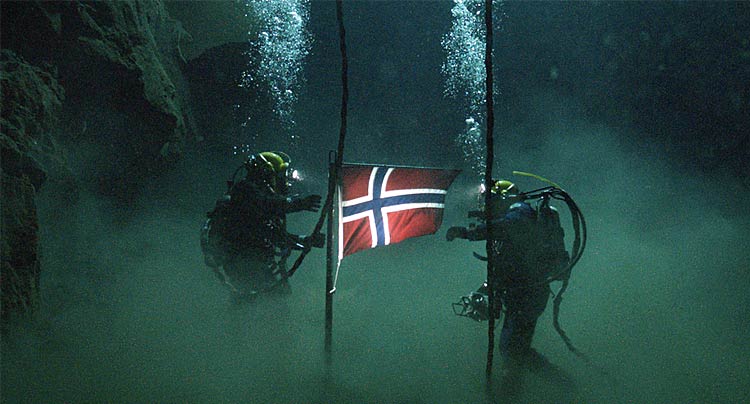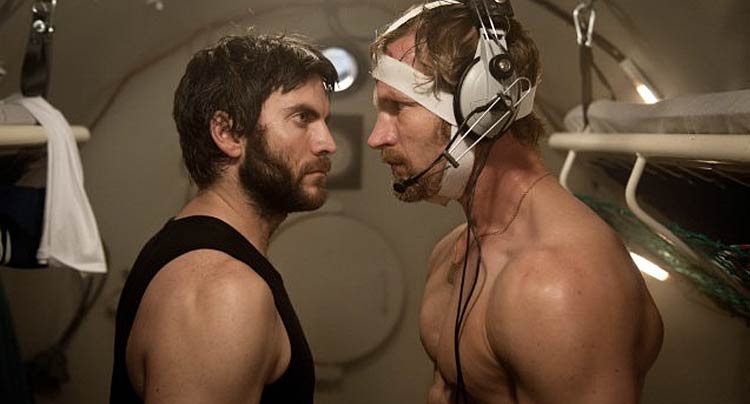
A Norwegian conspiracy thriller becomes one big knot of twists.

A Norwegian conspiracy thriller becomes one big knot of twists.
There are two movies playing out in the Norwegian film Pioneer. The first is a gritty procedural of a deep-sea dive, and the second, and more dominant, is a tense thriller. While at first glance these two separate stories of the film feel markedly different, even potentially at odds, they are two parts of a whole. Each shares a feeling of claustrophobia, physically and psychologically, that carries the film and makes it an engrossing experience.
Back in the late 1970’s, Norway discovered oil off its coastline and sought to build a pipeline. But the government would only agree to the pipeline’s construction on the condition that test dives were made to ensure the safety of the program. This required co-operating with an American company–here represented by Wes Bentley and Stephen Lang–that had the necessary equipment to successfully manage the dive. This makes for more than a simple cultural clash. First, it allows writer-director Erik Skjoldbjærg to play up the pernicious international interpretation of the United States as a domineering, empire-building bully. Second, it enables Skjoldbjærg to reference his debt to 1970’s American conspiratorial thrillers.
Little about the start of Pioneer’s initial premise suggests what it will turn into. Petter (Aksel Hennie) and his brother Knut (André Eriksen) are two of the Norwegian divers tasked with performing the test dive. Skjoldbjærg sketchily lays out their relationship, antagonistic but ultimately loving. They stand in stark contrast: Knut is a family man with a wife (Stephanie Sigman) and son; Petter is the slovenly uncle. Here the film finds some melodrama worthy of a very poorly written soap opera (and I say that as an apologetic fan of soaps). The film never convincingly establishes these relationships, but then again its real interests seem to lie elsewhere.

However, the film excels in other regards. During the dive, inexplicably something goes wrong, leaving Knut unconscious and his diving mask smashed open. In a fantastic, nerve-wracking scene, Petter gives Knut his oxygen tank and swims back up with his brother’s body, under threat of getting decompression sickness.
Skjoldbjærg’s manner for shooting this scene is one he takes for the rest of the film. He situates the viewer both in the psychological head space of his protagonist and the physical space of the environment. Both confining and paranoia-inducing.
At this point–about 40 minutes in–the film shifts gears. Knut doesn’t survive the incident, and Petter suspects foul-play. As Petter’s superiors and government agencies systematically deflect his concerns and questions, he becomes further convinced of his suspicions. But almost to the end of its runtime, Pioneer continues a sense of skepticism around Petter’s reliability. For one thing, prior to the dive, Petter and the other Norwegian divers were placed in a pressure chamber to test their ability to withstand the deep ocean pressures. The chamber had a hallucinatory effect on them. This element calls into question Petter’s credibility, and his obsession with discovering the truth becomes all-consuming as he grapples with his own grasp on reality.
A favorable opinion of Pioneer depends entirely on one’s response to the presentation of the plot. A favorable assessment might politely describe it as convoluted. The film’s plot is, centered as it is on a conspiracy, needlessly self-involved and complicated. But I think criticizing it for this misses the point. As previously mentioned, Skjoldbjærg draws inspiration from 1970’s American thrillers. These films–like The Parallax View and Three Days of the Condor–arose out of disillusionment after Watergate and the Vietnam War. While a few of these films have really great plots, they were more interested in a sustained feeling of paranoia and distrust, and they often had their conspiracies encompass just about everyone imaginable, including the highest reaches of government.

Pioneer does not attempt anything quite so vast and far-reaching, but does play around in that same convention of thrillers. Plot matters less here than a constant sense of dread and obscure mystery. Trying to pick apart the film and its plot is easy to do. The focus should be on the nervy, tension-filled pleasures of the film. (After all, The Parallax View, for example, does not make a lick of sense and is a standard of the genre). In its back-half, Pioneer holds an adrenaline-fueled single-mindedness: Petter is an everyman caught up in something even he does not quite fully understand. His investigation involves plenty of double crosses, reveals, counter-reveals, and moments of misdirection. Eventually the plot ceases to matter.
It helps that the film has such a strong visual design to support this shaky plot. Cinematographer Jallo Faber does an excellent job of creating a moody, anxious atmosphere. He nicely plays around with lights and shadows to capture the insidiousness at hand. Skjoldbjærg’s shoots a number of scenes in close-ups that emphasize the tight spaces and the feeling of being trapped. But every so often he will pull back and show a character dwarfed by their environment, as just another pawn in the game at hand. This is smart, involving filmmaking that elevates a premise that has only so much momentum to it. By its end, Pioneer drags out, running out of avenues in its loopy storytelling. After all, even the best conspiracies have their limits.